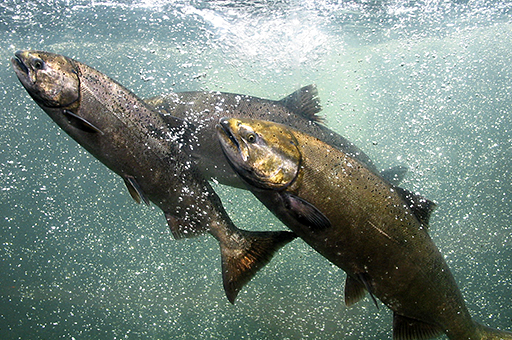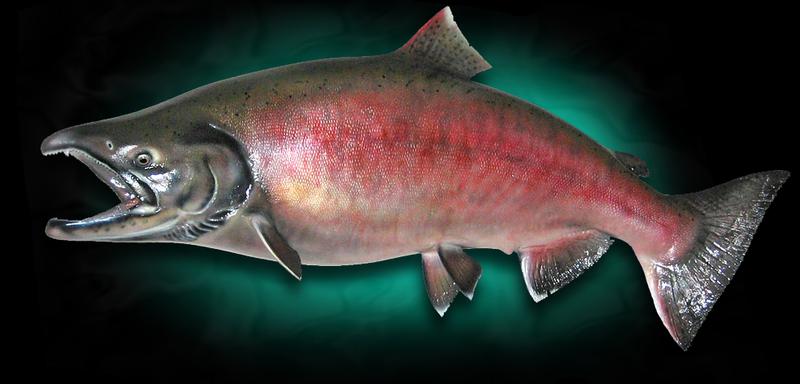
Trump Plan Allows Water Managers to Kill Off Winter-Run Chinook Salmon
Environmentalists call the new water diversion regulations “an extinction plan”
Alastair Bland / The East Bay Express
(November 5, 2019) — Eight-hundred pages into the text of a lengthy new report, federal biologists have quietly granted government water managers permission to nearly exterminate an endangered run of Sacramento River salmon so they can send more water south from the river’s delta to farmers in the arid San Joaquin Valley.
The so-called biological opinion, released Oct. 21 by the National Marine Fisheries Service in tandem with a similar review by the US Fish and Wildlife Service, analyzed the Trump Administration’s new water storage and delivery plan, which the US Bureau of Reclamation unveiled in January. That plan proposes to increase water withdrawals from the Sacramento-San Joaquin Delta by roughly 10 percent, often during critical migration periods for fish like chinook salmon and Delta smelt.
Because the water-pumping plan could impact threatened and endangered species, the Endangered Species Act required federal fisheries and wildlife agencies to review and assess the proposal, which they’ve done in their biological opinions. Two environmentalists who have read the documents closely — all 1,300 pages of them — warn that the federal government’s plans spell big trouble for little fish.
Of particular concern is a brief clause on page 801 of the National Marine Fisheries Service report that allows annihilation of the winter-run Chinook for three consecutive years before limits on water transfers would be imposed. Because most Chinook salmon spawn and naturally die at three years of age, annihilation of all newborns in three consecutive years would effectively wipe out the species.
Specifically, the document states that officials need not reconsider the new water limits unless “two consecutive years of egg-to-fry survival of less than 15 percent [are] followed by a third year of less than 21 percent.” In other words, the Bureau of Reclamation is permitted to safeguard so little of the cold water outflow from Shasta Dam — essential for spawning salmon — so that as much as 100 percent of offspring could die for three years in a row before officials would have to reconsider their regulations.

“This is an extinction plan,” warns Jon Rosenfield, a scientist with the organization San Francisco Baykeeper who has reviewed the report. “Zero plus zero plus zero equals zero, which means jeopardizing this species’ survival in the wild is explicitly permitted. This is directly contrary to the letter and spirit of the Endangered Species Act.”
The new biological opinions replace a pair of decade-old opinions from the same agencies that have guided the operation of the south-Delta pumping stations specifically to protect endangered fish species. But the old plans didn’t work very well. Under their storage and diversion regulations, first established in 2008 and 2009, Delta smelt numbers went from already low to nearly zero.
Salmon suffered, too; in 2014 and 2015, sloppy water storage behind the Bureau of Reclamation’s Shasta Dam caused almost complete extermination of winter-run Chinook eggs and fry, which fail to properly develop and can perish altogether in temperatures much above 56 degrees Fahrenheit.
In a July, 2018 recommendation, the State Water Resources Control Board determined that the survival of Delta species depends on water pumps taking less water from the estuary. “Existing regulatory minimum Delta outflows are too low to protect the ecosystem,” the report declared.
Currently, state and federal pumps pull between 4 million and 5 million acre-feet of water from the Delta each year — what state officials and other scientists have said is already too much. An acre-foot of water is the amount needed to cover one acre of land with one foot of water; an average California household uses between one and one-half acre-foot of water per year.
But rather than heeding that 2018 warning, federal biologists’ new pumping guidelines could send another 500,000 acre-feet of water south, mostly to farmers in the dry San Joaquin Valley, where lucrative orchards thrive on water sucked from distant river basins.
The Trump Administration’s new plan has been welcomed by such farmers, many of whom often gripe that too much of California’s water is reserved for ecological needs, creating endless hardship for growers.
In fact, California’s farming economy knows little but prosperity and growth. Every few years, the state’s almond growers report a new record crop, most of which is exported to Asia. Almond production continues to increase as farmers plant more and more trees, which environmentalists argue require too much water. Other crop sectors, like wine grapes, pistachios and dairy, also thrive.
Meanwhile, Chinook salmon runs, once a main source of protein for native Californians, have plunged from plentiful to pitiful. Large river systems that once collectively hosted millions of adult spawners every year, as well as huge coho and steelhead runs, now see spawning returns in the low tens of thousands.
Water diversions have played a major role in these salmon declines by dewatering streams entirely; causing water temperatures to spike and kill baby fish; and by sucking fish into the pumps, where tens of millions of salmon and smelt have died.
The new biological opinions, which could guide water policy for many years, also outline mitigation measures that ostensibly offset significant impacts. While the scientists who wrote the reports acknowledge that the proposed water diversion plan could cause significant fish mortality, they also concluded that the Bureau of Reclamation’s water pumping plans “will not jeopardize threatened or endangered species or adversely modify their critical habitat.” In fact, federal officials claim the new water plan will help the ailing Delta ecosystem.
“We have a plan that is much better for fish, farms, and communities than our current operations,” said Ernest Conant, a regional director with the Bureau of Reclamation.
But environmentalists are blowing the bullshit whistle. Doug Obegi, a water law attorney with the Natural Resources Defense Council, said the new plans are not to be trusted.
“Simply maintaining the status quo is a recipe for extinction, yet the Trump Administration is doing far worse than that,” said Obegi, who spent months reviewing the landmark documents while they were still in draft form.

Along with the chinook death allowance in the NMFS report, the two documents make numerous other allowances that Obegi warns will bring salmon, smelt and other species, such as green sturgeon, closer to extinction.
In its report, the Fish and Wildlife Service places no limits on the number of Delta smelt that can be killed at the Delta pumps, Obegi said. It also calls for habitat restoration efforts already required by the decade-old opinions, but never carried out.
Rosenfield said the Fish and Wildlife Service’s opinion places great emphasis on investment in hatcheries, which he called “planning for extirpation in the wild.”
The documents also eliminate previous restrictions meant to keep the pumps from reversing the flow of the San Joaquin River. When this happens, juvenile salmon migrating to the ocean may follow the backward flows into the lethal pumps. Scientists are skeptical of agency claims that the new pumping plan will help fish. The new regime will involve real-time monitoring for endangered Delta smelt. Then, when the fish are detected near the pumps, the Bureau of Reclamation will supposedly slow them down.
Rosenfield calls this theoretical approach “a fallacy.” That’s because Delta smelt are now so rare that catching them at all is very difficult. Research from the Fish and Wildlife Service has even found that for every smelt caught in sampling nets, as many as 1,000 may have died at the pumping stations.
Peter Moyle, a biologist at U.C. Davis and an expert on the Delta’s aquatic ecology, thinks such monitoring might not be so effective.
“They’re assuming you can micromanage the system this way, but that’s not an easy thing to do,” he said.
At the root of many people’s concerns is the political process that coughed up the reports. In July, federal biologists submitted a pair of draft opinions that warned the new pumping proposal could extinguish imperiled fish populations.
But instead of rewriting their proposed changes to water management operations, the Trump Administration replaced the naysayer staff scientists with a new team, who revised the documents into more favorable reviews — a stunning case of science flayed by politics.
Advocates for natural resources are now hoping that Gov. Gavin Newsom intervenes against the Trump Administration by enforcing state-level laws, like the California Endangered Species Act and other measures that would guarantee that sufficient Delta water flows through the estuary and into San Francisco Bay. No one is holding their breath, however. Just weeks ago, Newsom baffled many environmentalists when he vetoed SB 1, a proposal specifically crafted to protect state environmental laws from federal-level tinkering by Trump and his appointees.
Jeffrey Mount, a senior fellow at the Public Policy Institute of California, feels the conflicts likely to arise from the new federal plan underscore inconsistencies in the state’s water management structure and even suggest that it’s time to overhaul the system.
“There is no need to have the federal government running a water project that’s entirely within California,” he says. “It’s time that the feds relinquish control of the Central Valley Project to the State Water Project.”
Obegi said he expects the federal government to try to implement the new water plan in January, and he’s anticipating lawsuits.
“I suspect that conservation and fishing groups will be in court pretty darn quick,” he said.
Posted in accordance with Title 17, Section 107, US Code, for noncommercial, educational purposes.